Deborah Swift's Blog, page 39
June 6, 2013
Four books on writing that go beyond the basics
Like all writers, I love my craft. Many writing books are aimed at beginners and often give more experienced writers the same information re-packaged. As a writer who is already published you might think that I don't need to read any 'how to' books about writing, but actually the more I write the more interested I get in the subtle nuts and bolts of how storytelling works, and the more I admire other writers who do it differently.
If like me, you want to increase the subtlety in your work then I can recommend the following books. None of them is written by a writer I know, and none of them is about how to write a bestseller. What are your favourite books on writing? I'd love you to leave me a comment!
 179 ways to save a novel
179 ways to save a novel
Matters of Vital concern to Fiction writers by Peter Selgin The ideas in this book are grouped under six headings: Substance; Structure; Style; Symbol, Myth & Metaphor; Soul and Other Matters.
 Self Editing for Fiction writersHow to edit yourself into print by Renni Browne and Dave KingThis book has great examples and also wonderful cartoons, although it does cover ground that will be familiar to most, such as 'show not tell'. I include it because it is the best basic book on editing I have ever found, and the instructions are really clear.
Self Editing for Fiction writersHow to edit yourself into print by Renni Browne and Dave KingThis book has great examples and also wonderful cartoons, although it does cover ground that will be familiar to most, such as 'show not tell'. I include it because it is the best basic book on editing I have ever found, and the instructions are really clear.
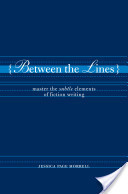
Between the LinesMaster the subtle Elements of Fiction writing by Jessica MorrellFew books attempt to explore subtleties of tone and voice. This book does just this. Most of the examples given are from the US and this can be off-putting if you are a Brit, but it is still a book well-worth reading.
The Art of Fiction Illustrated from classic and Modern texts by David LodgeA series of articles from The Independent on Sunday, this book covers such things as 'the intrusive author', 'intertextuality' and 'defamiliarization' using examples as diverse as Charlotte Bronte and Michael Frayn. It is a book of literary criticism from which writers can learn a lot, although it is not strictly speaking a 'how to' book. The examples in this book show just how far you can go as a writer to make your voice your own.
Illustrated from classic and Modern texts by David LodgeA series of articles from The Independent on Sunday, this book covers such things as 'the intrusive author', 'intertextuality' and 'defamiliarization' using examples as diverse as Charlotte Bronte and Michael Frayn. It is a book of literary criticism from which writers can learn a lot, although it is not strictly speaking a 'how to' book. The examples in this book show just how far you can go as a writer to make your voice your own.
If like me, you want to increase the subtlety in your work then I can recommend the following books. None of them is written by a writer I know, and none of them is about how to write a bestseller. What are your favourite books on writing? I'd love you to leave me a comment!
 179 ways to save a novel
179 ways to save a novel
Matters of Vital concern to Fiction writers by Peter Selgin The ideas in this book are grouped under six headings: Substance; Structure; Style; Symbol, Myth & Metaphor; Soul and Other Matters.
 Self Editing for Fiction writersHow to edit yourself into print by Renni Browne and Dave KingThis book has great examples and also wonderful cartoons, although it does cover ground that will be familiar to most, such as 'show not tell'. I include it because it is the best basic book on editing I have ever found, and the instructions are really clear.
Self Editing for Fiction writersHow to edit yourself into print by Renni Browne and Dave KingThis book has great examples and also wonderful cartoons, although it does cover ground that will be familiar to most, such as 'show not tell'. I include it because it is the best basic book on editing I have ever found, and the instructions are really clear.
Between the LinesMaster the subtle Elements of Fiction writing by Jessica MorrellFew books attempt to explore subtleties of tone and voice. This book does just this. Most of the examples given are from the US and this can be off-putting if you are a Brit, but it is still a book well-worth reading.
The Art of Fiction
 Illustrated from classic and Modern texts by David LodgeA series of articles from The Independent on Sunday, this book covers such things as 'the intrusive author', 'intertextuality' and 'defamiliarization' using examples as diverse as Charlotte Bronte and Michael Frayn. It is a book of literary criticism from which writers can learn a lot, although it is not strictly speaking a 'how to' book. The examples in this book show just how far you can go as a writer to make your voice your own.
Illustrated from classic and Modern texts by David LodgeA series of articles from The Independent on Sunday, this book covers such things as 'the intrusive author', 'intertextuality' and 'defamiliarization' using examples as diverse as Charlotte Bronte and Michael Frayn. It is a book of literary criticism from which writers can learn a lot, although it is not strictly speaking a 'how to' book. The examples in this book show just how far you can go as a writer to make your voice your own.
Published on June 06, 2013 07:40
May 6, 2013
Similes - What is writing like? by Aliya Whiteley
 Aliya Whiteley, author of
Aliya Whiteley, author of'Light Reading' and 'Three
Things About Me'
discusses similes
for writingWriting is like…
The world is filled with similes, but the act of writing gets more than its fair share of them. Writing is like having a baby, or spilling your heart on to the page. It’s like living with a house filled with strangers or doing a jigsaw puzzle without the front of the box to guide you.
I love these similes, but I’m not sure anyone has ever come up with a great comparison between writing and doing anything else. It’s a unique activity. You sit still and you think, and you think, and you sit. You tap on a keyboard, and you might go out to a library or a café once in a while, but mainly you write, every day, whenever you get the chance, and in the end a story is created.
That’s not so punchy as saying writing is like tap dancing naked in the rain, though, is it?
Here are three of my own writing similes. Let’s kick off with vegetables. Writing is like a vegetable. Here’s why:
Writing is like...
1. ...planting potatoes. You have to wait for the basic idea to start sprouting before you can stick it underground and let it work its way up to the surface. And when it gets to the surface and starts flowering you should put more earth around the base for a better yield. So that when you finally dig it up and start writing that novel, there are so many ideas under the surface that it's potato salad all round. Metaphorically speaking.
2. ....a broad bean. You don't want to overcook that baby or it's going to end up leathery.
3. ...making coleslaw. Make sure you shred the prose cabbage so finely that by the time you add the mayonnaise of the finishing touches the whole novel slips down nice and easy. Bleurgh. I hate coleslaw.
4. ...preparing a celeriac. Face it. At first it's going to look ugly, and you're going to have to put time and effort into sawing off all the knobbly bits. There'll be dirt and you might even slice your finger a little bit, but the pain is good. It means you're getting somewhere. Then you braise that celeriac with red onion and button mushrooms and serve it with a lovely piece of fresh salmon on the top. I mean, you serve up the finished novel. Obviously.
5. ...kohlrabi. The initial idea keeps turning up in your mental veggie box and you have no idea what you're going to do with it. So you chop it and dice it and mash it and squelch it and pound it and serve it up a million different ways until eventually one of the Masterchef judges/publishers says - actually, this is okay. Yeah. I can eat this. And then you rejoice for thirty seconds before picking up your knife, reaching for a fresh kohlrabi, and trying all over again.
Or perhaps writing is just like having a baby for these reasons:
- gestation is definitely involved.
- to get the thing out there you need to give a really big push. or two. or six hundred. And, golly, that really hurts.
- you feel warmly towards your little WIP sometimes, and other times you wish it would just hurry up and be done with you.
- eating a lot of cake is mandatory.
- when it's over with you're left with something you want to show off to friends, family, and the entire of Facebook and Twitter.
- although it's probably not as perfect as you'd hoped, and since "publication" date you seem to be having trouble sleeping.
- public appearances are fraught with difficulty, you've definitely put on weight, and how come you suddenly have to put up with so much shit?
But writing is definitely not like having a baby because:
- you can forget about writing, have a day off, and go and sit in the garden instead.
- once you've finished your little WIP you can dispose of it if you so choose.
- and you definitely don't have to put it through university or pay for its wedding to another little WIP.
- writing hurts. it really does. but, trust me on this, it doesn't hurt as much as having a baby.
- although while having the baby you can get lots of lovely drugs for free. When you're writing a novel, you have to pay for them yourself.
But I think writing is really just like yoghurt-making:
- There are many different ways to make yoghurt. People argue about the best way to make yoghurt, but really, there is no best way. There's just your own way. You can make yoghurt in the sunshine, or standing in the kitchen. You can use machines to help you make yoghurt, or you can do it the old-fashioned way, with your two hands. (And a bowl and a spoon, but that part of the analogy obviously doesn't fit so well, so we'll gloss over that.) Another person's way of making yoghurt will never work as well for you. You have to perfect your own yoghurt-making.
- Yoghurt can be all things to all people. Sometimes people want exciting, adventurous yoghurt. Sometimes people want soothing, soft yoghurt. Sometimes people even want Greek Yoghurt, which explains why Captain Corelli's Mandolin was such a success.
- Commercial yoghurt is looked down upon by yoghurt purists. Yoghurt with chunkier fruit pieces is usually considered to be harder to get through, but more rewarding when you reach the end of the pot.
- Celebrities should be stopped from making yoghurt. They foist their horrible yoghurt upon the rest of us. That, or they lie, and get a professional yoghurt maker to secretly make their yoghurt for them. This is despicable. Everyone please stop buying these celebrity yoghurts before all the old-school yoghurt-makers go out of business.
- In modern times, yoghurts come with accoutrements, such as little corner helpings of crunchy flakes. Or yoghurt comes in over-processed tubes, to be sucked down and instantly discarded. We are dressing up our yoghurts, but surely traditional yoghurt is the best? However, it is good to be open to changes in the yoghurt industry. Eventually yoghurt-makers will no longer need packaging and will simply squirt their yoghurts directly into the consumers' mouths. This is to be desired. Apron sales will also go up.
- Yoghurt buyers are very susceptible to yoghurt packaging. Women yoghurt buyers like pink pots. Men yoghurt buyers like manly pots in bigger sizes. It used to be true that nobody over the age of twelve wanted to be caught eating a child yoghurt in a ridiculous brightly-coloured little pot in public, but nowadays it's much more acceptable to say you like child yoghurt. Getting in touch with your inner toddler, or some such rubbish. Still, child yoghurts are lots of fun, aren't they? That Harry Potter yoghurt was excellent.
But, however you take your yoghurt, it will always be a very cultured thing to do.
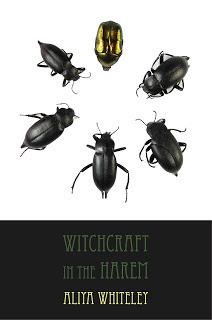
Aliya's book of literary fantasy short stories is out on 3oth April published by
www.doghornpublishing.com
You’re running away from something terrible. You think you’ve escaped it, this thing, but it turns out it’s waiting for you in all the places you hide: your house, your garden, a self-help group, a seraglio, the island of Zanzibar, a museum in Turin, a hot air balloon in Canada, even in the ladies’ room of your favourite nightclub. You’ve carried it into these places with you. It’s inside you. And now it’s time for it to come out.
This first collection of acclaimed short stories by Aliya Whiteley takes the reader to the strangest, deepest corners of life experience. Grotesque, unsettling, and often very funny, Witchcraft in the Harem deals with birth and betrayal, love and loss, and all the terrible thoughts we want to escape, and find still waiting for us at the journey’s end.
Acclaim for the Book
‘The experience of reading this collection is like being waterboarded by an angel. Shocking, heartbreaking and laugh-out-loud funny, this is some of the best writing I’ve ever seen. If you like Aimee Bender or Etgar Keret, you will love Witchcraft in the Harem.’ —World Fantasy Award-winner Lavie Tidhar
Aliya's Blog
What do you think writing is like?
Published on May 06, 2013 00:30
April 16, 2013
Novelists - how to use MS Word as a powerful editing tool
US author Maria Grace mentioned on facebook about using MS Word as an editing tool. I was intrigued so I asked her to come on the blog and tell us all about it. Over to Maria!
Thanks so much for hosting me Deborah. I’m so excited to get to talk a little about the bones of the writing process. I don’t get to do that very often.
When it comes to writing, I have no qualms about saying that line editing is my least favorite stage of the writing process. It is fiddly, nit-picky and just not a whole lot of fun. This of course means that I want to find the quickest, most efficient way of doing it in as few passes as possible and with tools that I already have.
So I did what all good writers do in such circumstances, I started researching. I read hundreds of articles on the art of line editing—making beautiful sentences that really work. I read about all sorts of expensive software to help the process. Then I read about features in MS word and realized I could get Word to do a lot of those fancy tricks with only a few steps. I found it so helpful, I would love to share my process with you.
When I get in line editing mode, it is more than anything else, a search and destroy function. I search out problems in the prose and rewrite them. Rewriting is the easy part, finding the spots that need work is the challenge. Using the notes I complied from the reams of writing articles I have read, I created lists of words that signal problems. I organized those lists into three groups: words that signal sloppy or wordy constructions, words that signal point of view problems, and gesturing words that tend to get overused. I use Word’s built in functions to find all the words on one list, correct those issues, then go on to the second and third list.
The function I use is the ‘replace all function.’ You can set it up to find specific words and replace them with a highlighted version of the same word. This will flag all the problems words, and if you add a touch of color coding to it, even signal what the likely problem is. Then, as you go in to do the actual editing, you can spot exactly what you need to do to fix it all.
The basic process is simple. (Scroll down the blog for the pictures which are at the end of the instructions - sorry, blogger is just not co-operating to let me insert them in the text today - Deborah)
1. Go into word and set the highlight function to a specific color. I start with yellow.(picture 1). I use 7-8 colors on each pass, each one for a different purpose. More on that bit later.
2. Then select ‘Replace’ from the far right menu on the ‘home’ tab in word. If you’re using an older version it is in the dropdown menu. (picture 2). For our first example, we’re going to search for present participles which end in –ing. So type ‘ing’ in the ‘Find what’ field and tick the ‘match suffix’ box in the right hand column.
3. In the ‘replace with’ box, type ‘ing’ just like you did in the ‘find what’ box. Then go to the very bottom and click the left hand button that says ‘more’. (picture 3) Select ‘highlight’. Your box will look like this: (picture 4). Click ‘replace all’, the third box under the ‘replace with’ field.
4. Your file will now look something like this: ( picture 5) All the suffix instances of ‘ing’ are highlighted and you can quickly identify all the present participle phrases that need to be axed. Keep in mind that there are legitimate uses of ‘ing’ words that you want to keep, so you will need to read to determine what you need to do. BUT, this makes finding those trouble spots quick and easy.
5. To take this to the next level, I will go to town and find multiple problem cases at once and handle a whole batch of corrections in a single editing pass. To do this, keep the ‘replace’ window open and go back to step one and select another highlight color. Just click on it, no problem.
6. Then fill in a new word into the ‘find what box’. For me the next search is for instances of ‘was’ and ‘were’—search and destroy passive voice. So I type in ‘was’ into the ‘find what’ and ‘replace with’ fields. Uncheck the ‘match suffix’ box and check the ‘find whole word only’ option in the left hand column. This will keep word from flagging instances of ‘w-a-s’ that occur in the middle of a word like ‘awash’.
7. Click ‘replace all’ and you will have a lovely multicolored version of your document.
8. Redo these steps for each problem word you want to catch. Change colors as described in step 5 whenever you need to. When you’re finished, your document will likely look like this: picture 7.
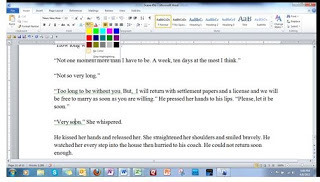 Picture 1
Picture 1
 Picture 2
Picture 2
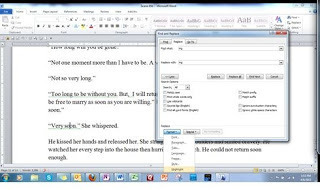 Picture 3
Picture 3
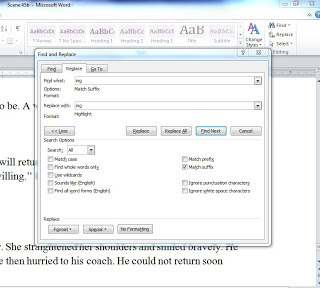 Picture 4
Picture 4
 Picture 5
Picture 5
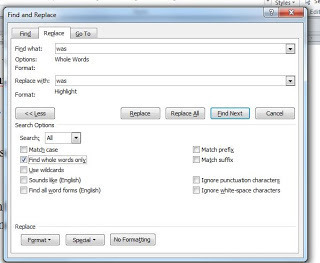 Picture 6
Picture 6
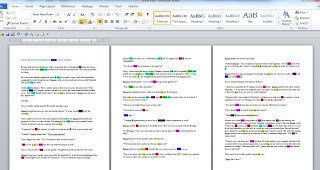 Picture 7You might think this a bit excessive, but the day I discovered I had used has/have/had twenty one times on a single page and had my characters sighing thirteen times on another page convinced me of the usefulness of this technique.
Picture 7You might think this a bit excessive, but the day I discovered I had used has/have/had twenty one times on a single page and had my characters sighing thirteen times on another page convinced me of the usefulness of this technique.
Naturally, the next question is what to highlight and why. I have a handy little list I use for each of my three passes. You may have different problem areas, but this will give you a sense of the kinds of things to look for.
Pass 1: Sloppy and wordy construction Color Yellow: -ing
Why: Present participle phrases. Click here (http://edittorrent.blogspot.com/search/label/series-%20ongoing%20rants%20on%20PPPs) for an explanation on why those need to go.
Color Turquoise: was, were
Why: passive words to replace with active
Color Pink: had, has, have
Why: passive, dull constructions
Color Lime Green: it, there, here
Why: vague pronouns, should be replaced with something more dynamic
Color Red: that, but
Why: overused and lazy conjunctions
Color Light Grey: every preposition known to man (here’s a short list: www.englishclub.com/vocabulary/prepositions-list.htm)
Why??? What do I have against prepositions? Overuse. Nearly half of the prepositional phrases in my writing can be replaced with one or two better, clearer words.
Color Bright Blue: together, start, plan, almost, just, then, own, thing, began, reach, rather, instead, even, back
Why: tend to be unnecessary and wordy
Color Purple: very, good, great, really, suddenly, finally, about, only, totally, eventually, almost, exactly, fairly, so, such
Why: weak adjectives and adverbs that should be removed or replaced.
After my document looks like a class of kindergarteners attacked it with an entire box of crayolas, I go through and rewrite according to all the problems that turned up. Often, when sentences have several problem words, I can fix all of them with one simple rewrite, so it is worth it to have all the problems flagged at once. The last time I did this, I edited out 10,000 words from an 88,000 word document. I did not remove any ‘meat’ just slimmed down and streamlined by writing.
After I do the ‘sloppy writing’ pass, then I will do another round of highlights to ferret out potential point of view issues by searching for filtering words. I pick up a lot of subtle problems this way. Click here(http://www.publishingcrawl.com/2012/05/21/filter-words/) and here (http://writeitsideways.com/are-these-filter-words-weakening-your-fiction/) for some great articles on the subject and lists of words to look for. If anyone is interested in my lists, mention it in the comments section and I can post them in the comments or on my own site.
The third pass I use is all about gesturing words and speech tags. Using the same basic strategy, I colorize those to be check and make sure that my characters aren’t nodding, sighing and smiling all the time. This can also be useful if you have a character with a ‘tell’ or a specific move, like an eye twitch. You can quickly identify all the twitches and make sure that no one else is doing them.
A lot of consistency issues can be checked out this way, too. For example, if a character goes by a nickname with some people, you can highlight it and make sure that nickname turns up in the right places and not in the wrong ones. So many possibilities with this approach!
I even use this technique to help me proofread for punctuation. But that is another post.
Oh, one last thing, for the geekier among us, Word does have a ‘macro’ feature which allows you to program stuff like this into a single mouse-click. I’m working on that right now…
Thanks so much for having me today, Deborah!
Many thanks to Maria for sharing these really useful tips, ideas we can all usefully use in our editing process.
About Maria Grace -Though Maria Grace has been writing fiction since she was ten years old, those early efforts happily reside in a file drawer and are unlikely to see the light of day again, for which many are grateful. She has one husband, two graduate degrees and two black belts, three sons, four undergraduate majors, five nieces, six cats, seven Regency-era fiction projects and notes for eight more writing projects in progress. To round out the list, she cooks for nine in order to accommodate the growing boys and usually makes ten meals at a time so she only cooks twice a month.
email: author.MariaGrace@gmail.com.
Facebook: www.facebook.com/AuthorMariaGrace Web: Random Bits of Fascination www.AuthorMariaGrace.com
Twitter @WriteMariaGrace Pinterest : http://pinterest.com/mariagrace423/
 What is a young woman to do? One handsome young man has all the goodness, while the other the appearance of it. How is she to separate the gentleman from the cad?
What is a young woman to do? One handsome young man has all the goodness, while the other the appearance of it. How is she to separate the gentleman from the cad?
When Darcy joins his friend, Bingley on a trip to Meryton, the last thing on his mind is finding a wife. Meeting Elizabeth Bennet changes all that, but a rival for his affections appears from a most unlikely quarter. He must overcome his naturally reticent disposition if he is to have a chance of winning her favor. Elizabeth’s thoughts turn to love and marriage after her sister Mary’s engagement. In a few short weeks, she goes from knowing no eligible young men, to being courted by two. Both are handsome gentleman, but one conceals secrets and the other conceals his regard. Will she determine which is which before she commits to the wrong one?
Thanks so much for hosting me Deborah. I’m so excited to get to talk a little about the bones of the writing process. I don’t get to do that very often.
When it comes to writing, I have no qualms about saying that line editing is my least favorite stage of the writing process. It is fiddly, nit-picky and just not a whole lot of fun. This of course means that I want to find the quickest, most efficient way of doing it in as few passes as possible and with tools that I already have.
So I did what all good writers do in such circumstances, I started researching. I read hundreds of articles on the art of line editing—making beautiful sentences that really work. I read about all sorts of expensive software to help the process. Then I read about features in MS word and realized I could get Word to do a lot of those fancy tricks with only a few steps. I found it so helpful, I would love to share my process with you.
When I get in line editing mode, it is more than anything else, a search and destroy function. I search out problems in the prose and rewrite them. Rewriting is the easy part, finding the spots that need work is the challenge. Using the notes I complied from the reams of writing articles I have read, I created lists of words that signal problems. I organized those lists into three groups: words that signal sloppy or wordy constructions, words that signal point of view problems, and gesturing words that tend to get overused. I use Word’s built in functions to find all the words on one list, correct those issues, then go on to the second and third list.
The function I use is the ‘replace all function.’ You can set it up to find specific words and replace them with a highlighted version of the same word. This will flag all the problems words, and if you add a touch of color coding to it, even signal what the likely problem is. Then, as you go in to do the actual editing, you can spot exactly what you need to do to fix it all.
The basic process is simple. (Scroll down the blog for the pictures which are at the end of the instructions - sorry, blogger is just not co-operating to let me insert them in the text today - Deborah)
1. Go into word and set the highlight function to a specific color. I start with yellow.(picture 1). I use 7-8 colors on each pass, each one for a different purpose. More on that bit later.
2. Then select ‘Replace’ from the far right menu on the ‘home’ tab in word. If you’re using an older version it is in the dropdown menu. (picture 2). For our first example, we’re going to search for present participles which end in –ing. So type ‘ing’ in the ‘Find what’ field and tick the ‘match suffix’ box in the right hand column.
3. In the ‘replace with’ box, type ‘ing’ just like you did in the ‘find what’ box. Then go to the very bottom and click the left hand button that says ‘more’. (picture 3) Select ‘highlight’. Your box will look like this: (picture 4). Click ‘replace all’, the third box under the ‘replace with’ field.
4. Your file will now look something like this: ( picture 5) All the suffix instances of ‘ing’ are highlighted and you can quickly identify all the present participle phrases that need to be axed. Keep in mind that there are legitimate uses of ‘ing’ words that you want to keep, so you will need to read to determine what you need to do. BUT, this makes finding those trouble spots quick and easy.
5. To take this to the next level, I will go to town and find multiple problem cases at once and handle a whole batch of corrections in a single editing pass. To do this, keep the ‘replace’ window open and go back to step one and select another highlight color. Just click on it, no problem.
6. Then fill in a new word into the ‘find what box’. For me the next search is for instances of ‘was’ and ‘were’—search and destroy passive voice. So I type in ‘was’ into the ‘find what’ and ‘replace with’ fields. Uncheck the ‘match suffix’ box and check the ‘find whole word only’ option in the left hand column. This will keep word from flagging instances of ‘w-a-s’ that occur in the middle of a word like ‘awash’.
7. Click ‘replace all’ and you will have a lovely multicolored version of your document.
8. Redo these steps for each problem word you want to catch. Change colors as described in step 5 whenever you need to. When you’re finished, your document will likely look like this: picture 7.
 Picture 1
Picture 1 Picture 2
Picture 2 Picture 3
Picture 3 Picture 4
Picture 4 Picture 5
Picture 5 Picture 6
Picture 6 Picture 7You might think this a bit excessive, but the day I discovered I had used has/have/had twenty one times on a single page and had my characters sighing thirteen times on another page convinced me of the usefulness of this technique.
Picture 7You might think this a bit excessive, but the day I discovered I had used has/have/had twenty one times on a single page and had my characters sighing thirteen times on another page convinced me of the usefulness of this technique. Naturally, the next question is what to highlight and why. I have a handy little list I use for each of my three passes. You may have different problem areas, but this will give you a sense of the kinds of things to look for.
Pass 1: Sloppy and wordy construction Color Yellow: -ing
Why: Present participle phrases. Click here (http://edittorrent.blogspot.com/search/label/series-%20ongoing%20rants%20on%20PPPs) for an explanation on why those need to go.
Color Turquoise: was, were
Why: passive words to replace with active
Color Pink: had, has, have
Why: passive, dull constructions
Color Lime Green: it, there, here
Why: vague pronouns, should be replaced with something more dynamic
Color Red: that, but
Why: overused and lazy conjunctions
Color Light Grey: every preposition known to man (here’s a short list: www.englishclub.com/vocabulary/prepositions-list.htm)
Why??? What do I have against prepositions? Overuse. Nearly half of the prepositional phrases in my writing can be replaced with one or two better, clearer words.
Color Bright Blue: together, start, plan, almost, just, then, own, thing, began, reach, rather, instead, even, back
Why: tend to be unnecessary and wordy
Color Purple: very, good, great, really, suddenly, finally, about, only, totally, eventually, almost, exactly, fairly, so, such
Why: weak adjectives and adverbs that should be removed or replaced.
After my document looks like a class of kindergarteners attacked it with an entire box of crayolas, I go through and rewrite according to all the problems that turned up. Often, when sentences have several problem words, I can fix all of them with one simple rewrite, so it is worth it to have all the problems flagged at once. The last time I did this, I edited out 10,000 words from an 88,000 word document. I did not remove any ‘meat’ just slimmed down and streamlined by writing.
After I do the ‘sloppy writing’ pass, then I will do another round of highlights to ferret out potential point of view issues by searching for filtering words. I pick up a lot of subtle problems this way. Click here(http://www.publishingcrawl.com/2012/05/21/filter-words/) and here (http://writeitsideways.com/are-these-filter-words-weakening-your-fiction/) for some great articles on the subject and lists of words to look for. If anyone is interested in my lists, mention it in the comments section and I can post them in the comments or on my own site.
The third pass I use is all about gesturing words and speech tags. Using the same basic strategy, I colorize those to be check and make sure that my characters aren’t nodding, sighing and smiling all the time. This can also be useful if you have a character with a ‘tell’ or a specific move, like an eye twitch. You can quickly identify all the twitches and make sure that no one else is doing them.
A lot of consistency issues can be checked out this way, too. For example, if a character goes by a nickname with some people, you can highlight it and make sure that nickname turns up in the right places and not in the wrong ones. So many possibilities with this approach!
I even use this technique to help me proofread for punctuation. But that is another post.
Oh, one last thing, for the geekier among us, Word does have a ‘macro’ feature which allows you to program stuff like this into a single mouse-click. I’m working on that right now…
Thanks so much for having me today, Deborah!
Many thanks to Maria for sharing these really useful tips, ideas we can all usefully use in our editing process.
About Maria Grace -Though Maria Grace has been writing fiction since she was ten years old, those early efforts happily reside in a file drawer and are unlikely to see the light of day again, for which many are grateful. She has one husband, two graduate degrees and two black belts, three sons, four undergraduate majors, five nieces, six cats, seven Regency-era fiction projects and notes for eight more writing projects in progress. To round out the list, she cooks for nine in order to accommodate the growing boys and usually makes ten meals at a time so she only cooks twice a month.
email: author.MariaGrace@gmail.com.
Facebook: www.facebook.com/AuthorMariaGrace Web: Random Bits of Fascination www.AuthorMariaGrace.com
Twitter @WriteMariaGrace Pinterest : http://pinterest.com/mariagrace423/
 What is a young woman to do? One handsome young man has all the goodness, while the other the appearance of it. How is she to separate the gentleman from the cad?
What is a young woman to do? One handsome young man has all the goodness, while the other the appearance of it. How is she to separate the gentleman from the cad? When Darcy joins his friend, Bingley on a trip to Meryton, the last thing on his mind is finding a wife. Meeting Elizabeth Bennet changes all that, but a rival for his affections appears from a most unlikely quarter. He must overcome his naturally reticent disposition if he is to have a chance of winning her favor. Elizabeth’s thoughts turn to love and marriage after her sister Mary’s engagement. In a few short weeks, she goes from knowing no eligible young men, to being courted by two. Both are handsome gentleman, but one conceals secrets and the other conceals his regard. Will she determine which is which before she commits to the wrong one?
Published on April 16, 2013 01:42
April 12, 2013
Historical Fiction Book Fair - Welcome to Mr Crespi's bookshop
Welcome Book Browsers at the Historical Novelists Book Fair.
Oh, good afternoon mistress, it's you. How delightful to see you again. Which book will you choose I wonder? You can see I have quite a few on my lovely shelves, but might I suggest these? You can see I have marked one of them at the top right with a slip of paper so I can find it easily. The other lies open at the bottom of the shelf, for as you can see I have just finished copying it especially for you. That was quite a labour of love I can tell you.
 Painting by Giuseppe Crespi, 1665 -1737What? You prefer a new-fangled typed version? Well I'm only too happy to oblige, but for that you will have to contact my apprentice Joseph Amazon. He is only a click away in the dusty warehouse. Last time I saw him he was trying to sort out a mountain of unsold books. I hope he manages to sell a few sometime, otherwise I fear the moths will eat the bindings and spidery cobwebs will glue them forever to the shelves.
Painting by Giuseppe Crespi, 1665 -1737What? You prefer a new-fangled typed version? Well I'm only too happy to oblige, but for that you will have to contact my apprentice Joseph Amazon. He is only a click away in the dusty warehouse. Last time I saw him he was trying to sort out a mountain of unsold books. I hope he manages to sell a few sometime, otherwise I fear the moths will eat the bindings and spidery cobwebs will glue them forever to the shelves.
If you are still a little uncertain about your choice, can I suggest you use the magic lantern device below which might tempt you with its live action tale of two sisters on the run in the gilded mansions and poor hovels of old London. This book has been a very popular choice amonst young ladies visiting my shop, second only to 'The Gentlewoman's Guide to Snaring a Man.' In fact many have said that they found it so thrilling they had to be revived with a nip of smelling salts by their worried husbands.
A spellbinding historical novel of beauty and greed and surprising redemption.England, 1660. Ella Appleby believes she is destined for better things than slaving as a housemaid and dodging the blows of her drunken father. When her employer dies suddenly, she seizes her chance--taking his valuables and fleeing the countryside with her sister for the golden prospects of London. But London may not be the promised land she expects. Work is hard to find, until Ella takes up with a dashing and dubious gentleman with ties to the London underworld. Meanwhile, her old employer's twin brother is in hot pursuit of the sisters.Set in a London of atmospheric coffee houses, gilded mansions, and shady pawnshops hidden from rich men's view, Deborah Swift's The Gilded Lily is a dazzling novel of historical adventure.
You like it? That's splendid. By strange coincidence the book is on special offer at the moment, so hurry on over to the warehouse where Master Amazon will be pleased to deliver a copy of The Gilded Lily direct to your address. Now that's what I call service.
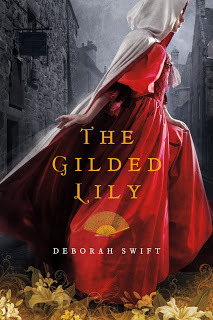
Many thanks for stopping by my humble bookstore and I hope to have the pleasure of serving you again in the near future. What's that? Oh yes, I'll send The Gentlewoman's Guide to Snaring a Man along with it. A plain brown wrapper? Certainly madam.
The other participating emporia are listed here
Oh, good afternoon mistress, it's you. How delightful to see you again. Which book will you choose I wonder? You can see I have quite a few on my lovely shelves, but might I suggest these? You can see I have marked one of them at the top right with a slip of paper so I can find it easily. The other lies open at the bottom of the shelf, for as you can see I have just finished copying it especially for you. That was quite a labour of love I can tell you.
 Painting by Giuseppe Crespi, 1665 -1737What? You prefer a new-fangled typed version? Well I'm only too happy to oblige, but for that you will have to contact my apprentice Joseph Amazon. He is only a click away in the dusty warehouse. Last time I saw him he was trying to sort out a mountain of unsold books. I hope he manages to sell a few sometime, otherwise I fear the moths will eat the bindings and spidery cobwebs will glue them forever to the shelves.
Painting by Giuseppe Crespi, 1665 -1737What? You prefer a new-fangled typed version? Well I'm only too happy to oblige, but for that you will have to contact my apprentice Joseph Amazon. He is only a click away in the dusty warehouse. Last time I saw him he was trying to sort out a mountain of unsold books. I hope he manages to sell a few sometime, otherwise I fear the moths will eat the bindings and spidery cobwebs will glue them forever to the shelves. If you are still a little uncertain about your choice, can I suggest you use the magic lantern device below which might tempt you with its live action tale of two sisters on the run in the gilded mansions and poor hovels of old London. This book has been a very popular choice amonst young ladies visiting my shop, second only to 'The Gentlewoman's Guide to Snaring a Man.' In fact many have said that they found it so thrilling they had to be revived with a nip of smelling salts by their worried husbands.
A spellbinding historical novel of beauty and greed and surprising redemption.England, 1660. Ella Appleby believes she is destined for better things than slaving as a housemaid and dodging the blows of her drunken father. When her employer dies suddenly, she seizes her chance--taking his valuables and fleeing the countryside with her sister for the golden prospects of London. But London may not be the promised land she expects. Work is hard to find, until Ella takes up with a dashing and dubious gentleman with ties to the London underworld. Meanwhile, her old employer's twin brother is in hot pursuit of the sisters.Set in a London of atmospheric coffee houses, gilded mansions, and shady pawnshops hidden from rich men's view, Deborah Swift's The Gilded Lily is a dazzling novel of historical adventure.
You like it? That's splendid. By strange coincidence the book is on special offer at the moment, so hurry on over to the warehouse where Master Amazon will be pleased to deliver a copy of The Gilded Lily direct to your address. Now that's what I call service.

Many thanks for stopping by my humble bookstore and I hope to have the pleasure of serving you again in the near future. What's that? Oh yes, I'll send The Gentlewoman's Guide to Snaring a Man along with it. A plain brown wrapper? Certainly madam.
The other participating emporia are listed here
Published on April 12, 2013 00:00
April 10, 2013
10 Questions with Ella Appleby of The Gilded Lily
For a bit of fun, Ella Appleby a character from my novel The Gilded Lily reveals all!
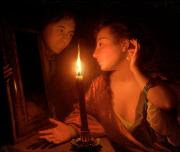 Godfried Shalcken - Lady examining herself in a mirror
Godfried Shalcken - Lady examining herself in a mirror
Favourite Colour: Gold, or scarlet, or a combination of both, preferably red silkwith real gold braiding.
Favourite Animal: A throughbred horse, preferably pulling the brand new shiny carriage in which she is riding.
Favourite Number: 1661 – the year in which she hopes her life will be transformed for the better and she will finally cease to be a servant.
Favourite Non-alcoholic Drink: A hot posset of eggs and ale – yes she knows that is alcoholic, but in the climate of the Little Ice Age, she needs something warming.
Facebook or Twitter?: Ella is a bit lazy, so Twitter would be her thing, but she might use facebook to spy on social contacts who are further up the social ladder.
Her Passion: To leave her life of drudgery, to be treated as she feels she deserves – as a fine lady. Her dream is to wear soft kidskin slippers instead of heavy wooden clogs.
Giving or getting presents: Definitely getting.
Favorite Day: The day she is first offered a position in The Gilded Lily, a beauty parlour where women can buy salves, potions and unguents to improve their appearance.
Favorite Flowers: Lilies of course. But also partial to a red rose from the hand of an admirer.
Favourite Book: Ella can't read but she likes listening to tales told out loud, the more outrageous the better. And she likes to tell a few tales herself, particularly if it gets her out of trouble.
This game was passed to me by Jo-Ann Butler, and I am passing it on to Grace Elliott.
 Godfried Shalcken - Lady examining herself in a mirror
Godfried Shalcken - Lady examining herself in a mirrorFavourite Colour: Gold, or scarlet, or a combination of both, preferably red silkwith real gold braiding.
Favourite Animal: A throughbred horse, preferably pulling the brand new shiny carriage in which she is riding.
Favourite Number: 1661 – the year in which she hopes her life will be transformed for the better and she will finally cease to be a servant.
Favourite Non-alcoholic Drink: A hot posset of eggs and ale – yes she knows that is alcoholic, but in the climate of the Little Ice Age, she needs something warming.
Facebook or Twitter?: Ella is a bit lazy, so Twitter would be her thing, but she might use facebook to spy on social contacts who are further up the social ladder.
Her Passion: To leave her life of drudgery, to be treated as she feels she deserves – as a fine lady. Her dream is to wear soft kidskin slippers instead of heavy wooden clogs.
Giving or getting presents: Definitely getting.
Favorite Day: The day she is first offered a position in The Gilded Lily, a beauty parlour where women can buy salves, potions and unguents to improve their appearance.
Favorite Flowers: Lilies of course. But also partial to a red rose from the hand of an admirer.
Favourite Book: Ella can't read but she likes listening to tales told out loud, the more outrageous the better. And she likes to tell a few tales herself, particularly if it gets her out of trouble.
This game was passed to me by Jo-Ann Butler, and I am passing it on to Grace Elliott.
Published on April 10, 2013 02:09
April 7, 2013
What's blogging ever done for me?
I have just been over to Hoydens and Firebrands blog to put up a post about Rakes and Rogues of the Restoration. Hoydens and Firebrands is the place where I can reach other fans of the seventeenth century, a period in which I have written three novels. The blog has a small but enthusiastic following.
Blogging takes up quite a lot of my writing time, so why do it?
Firstly, it is interesting and a writing challenge to compile a short informative piece that does not take long to read, but gives a good introduction to the subject. Usually I have already done the research for the post whilst researching my novels, but a blog post is different. I try to make these short posts visual and include links and references where possible for those who want to follow up the subject in more detail. Blogposts have actually been invaluable to print off and use as brief notes on my subject matter when I talk to Library groups or Book Clubs about my books and my research.
Secondly, I get to interact with people I have never met, but who share my passion for historical fiction. Through blogging I have had one or two great invitations. My blog posts through Debra Brown at English Historical Fiction Authors Blog will appear later this year in a new anthology, Castles Customs and Kings

This means my posts will be more widely read and appreciated.
Thirdly,through blogging I was invited to appear on two panels at The Historical Novel Conference 2013 in Florida. Of course I could have said no, that's too far to travel, but instead we have incorporated it into our family holiday, and I am now looking forward to meeting US fans of historical fiction and US writers who I only know from their icons online.
Here is a video showing the conference in London this year, and I'm sure Florida will be just as great.
Fourthly, It is my pleasure to promote other authors of historical Fiction via my other blog,
Royalty Free Fiction, where I can find other great new reads and help promote the genre in general. This blog focusses on books which do not have the draw of royalty (ie Kings and Queens) to help them gain a readership. Through doing this I have been made aware of many fantastic books I might otherwise have missed.
This is not to mention the great book bloggers who hosted me on my virtual tours with The Gilded Lily and took the time to review it. I appreciated them all, not to mention Amy Bruno from Passages in the Past who set up the tours.
So what's blogging done for me?
Quite a lot actually!
Blogging takes up quite a lot of my writing time, so why do it?
Firstly, it is interesting and a writing challenge to compile a short informative piece that does not take long to read, but gives a good introduction to the subject. Usually I have already done the research for the post whilst researching my novels, but a blog post is different. I try to make these short posts visual and include links and references where possible for those who want to follow up the subject in more detail. Blogposts have actually been invaluable to print off and use as brief notes on my subject matter when I talk to Library groups or Book Clubs about my books and my research.
Secondly, I get to interact with people I have never met, but who share my passion for historical fiction. Through blogging I have had one or two great invitations. My blog posts through Debra Brown at English Historical Fiction Authors Blog will appear later this year in a new anthology, Castles Customs and Kings

This means my posts will be more widely read and appreciated.
Thirdly,through blogging I was invited to appear on two panels at The Historical Novel Conference 2013 in Florida. Of course I could have said no, that's too far to travel, but instead we have incorporated it into our family holiday, and I am now looking forward to meeting US fans of historical fiction and US writers who I only know from their icons online.
Here is a video showing the conference in London this year, and I'm sure Florida will be just as great.
Fourthly, It is my pleasure to promote other authors of historical Fiction via my other blog,
Royalty Free Fiction, where I can find other great new reads and help promote the genre in general. This blog focusses on books which do not have the draw of royalty (ie Kings and Queens) to help them gain a readership. Through doing this I have been made aware of many fantastic books I might otherwise have missed.
This is not to mention the great book bloggers who hosted me on my virtual tours with The Gilded Lily and took the time to review it. I appreciated them all, not to mention Amy Bruno from Passages in the Past who set up the tours.
So what's blogging done for me?
Quite a lot actually!
Published on April 07, 2013 03:37
March 22, 2013
Creating Secondary Characters in Historical Fiction
Riddle: How does an author use historical fact to create and describe secondary or minor characters in historical fiction?
 I asked Jane Harlond, another fan of the 17th century, to tell me her process. Over to Jane:Following on from Helen Hollick’s fascinating discussion of her protagonists I’d like to talk about secondary and minor characters in historical fiction.
I asked Jane Harlond, another fan of the 17th century, to tell me her process. Over to Jane:Following on from Helen Hollick’s fascinating discussion of her protagonists I’d like to talk about secondary and minor characters in historical fiction.Secondary characters are often used to develop the main character(s) and/or move the plot. Whether or not the protagonist was a real person these characters are frequently fictional constructs, and, like minor characters, in the story to serve a purpose. They do, however, have to be believable; meaning they should develop or change during the course of the novel, and have identifiable strengths, foibles or flaws readers can relate to. An example of this is my character Marcos Alonso Almendro in The Chosen Man(Knox Robinson Publishing, 2012). Here’s a scene from the novel where the main character, wicked, wily Genovese merchant Ludo da Portovenere is making his first moves to manipulate the tulip market in Holland during the 1630s. He and Marcos, who is acting as his servant, are in a tavern. This is where Marcos is introduced to his first taste of coffee.
Amsterdam , early June 1635 Leaving a glorious day of bright summer sunshine, Marcos followed Ludo through a door and stepped into a netherworld of peat-filled grates and dark afternoons. It wasn’t the typical atmosphere of Dutch taverns he had already come to know – that particular hush broken by hearty guffaws and back-slapping camaraderie – this place was a composite of scents and sounds he could not name. There was one odour in particular, a pleasant aroma but not the usual malty smell of warm beer, nor the clear liquid that they served in thumb-sized tumblers that smelled like a woman’s perfume. He stopped and inhaled. “Coffee,” said Ludo. “Like it?” “It’s wonderful.” “Doesn’t taste as good as it smells, but you can add it to your list of new accomplishments.” Marcos gulped, the bastard knew about his journal. He knew everything – all the time! But the Italian wasn’t interested in him, his eyes were scanning the darkness: an eagle-owl detecting its prey in the half-light. Groups of men smoking curled-stem pipes were gathered around circular tables. Above, on a balcony, six or seven burghers huddled in negotiation. One smaller table was occupied by a single client. Ludo put a hand on Marcos’ shoulder and steered him towards a corner. A stub of candle stuck in a wine bottle flickered as they disturbed the heavy air. “Why’s it so dark?” Marcos asked.“So people can’t see each other I expect.” Ludo removed his wide brimmed hat and placed it conspicuously on top of his miniature sea chest in the centre of their table (. . .) settled himself into a chair and leaning back in his customary manner, gazed around him. “Dark is what they are used to,” he said. “Light is a special commodity in the Low Countries and your average Dutchman is too tight-fisted to waste money on candles. Candles offer no material return by definition.” “You don’t like the Dutch, do you?” “On the contrary, I enjoy them greatly: trying to out-manoeuvre them is one of my favourite pastimes. Successful strategy is the finer point of profit, Marcos. If you don’t like ...” He was interrupted by the serving girl. Marcos watched the way the plump wench looked at Ludo. What did women see in him? He wasn’t good-looking. Could they smell his money?“I’ve ordered coffee for you to try, but not at this table. You’re my servant remember, you should be over there.” Ludo nodded in the direction of the kitchen area. “But stay close and keep an eye out for onlookers. I’m expecting company and I want to know who sees us talking. If you notice anyone taking a special interest, follow him. Find out who he is, and where he lives if you can. I’ll see you back at the lodging tonight if we are separated.” “Yes sir.” Marcos got up and doffed his soft cloth hat. It wasn’t a fatuous move, Ludo’s tone was too serious for that. “Chat up the waitress,” added his master, “see if that man up there by himself is a regular or if he just came in today.” “How shall I do that? I don’t speak Dutch – or French – and she won’t have any Latin.” “You’ll manage. Languages are only an obstacle to people with no imagination. Do you have an imagination, Marcos?” . . .
Marcos leaned against the high trestle table that acted as a bar at the back of the tavern. The waitress placed a small white china cup beside him and smiled. He winked and lifted the cup. Keeping his eyes on the girl’s blue gaze he gulped the hot brown liquid. The wench smiled as his eyes opened in shock and surprise. He would have spat out the foul tasting stuff immediately but she was in his direct line of fire: she’d put herself there on purpose. He moved the scalding, bitter liquid around his mouth and forced himself to swallow. The cheeky wench laughed, said something incomprehensible and raised a hand holding a bowl of brown granules. With her free hand she spooned some into his cup and stirred. Marcos stared at the brown poison. He was going to have to drink it. The girl mimicked his wink and waited until he had the cup to his lips again before skipping off to serve new customers. Marcos took just a very small sip. It tasted better. In fact it was quite nice. Crossing one leg in front of the other and leaning sideways with an elbow on the high bench behind him, in what he considered the appropriate stance for a coffee habitué, he took in his murky surroundings. The door to the street opened and in that instant of light something on the balcony caught his eye, he glanced up. Something had glinted. That something was a pair of round spectacles on the round face of a gnome-like creature from a children’s fairy tale; a shoemaker, a tailor. Whoever and whatever he was, he was bending down observing Ludo through the balcony railings with far too much interest. Marcos looked for the girl; now he needed to find out about two men. But exactly how he was going to learn anything at all was quite beyond his imagination.
Without knowing it at the time, this scene follows Helen Hollick’s tips for writing historical fiction, with one exception. Regarding her first point on research and story, I tried to put myself into the setting to create the atmosphere and imagined what it must have been like in a Dutch tavern in1635. I needed the secondary character, Marcos, to start acting on his own, and I needed to show the protagonist, Ludo, was not to be trusted. Fact in historical fiction is vital: accuracy in setting and detail is essential. But, when it comes to the plot and fictional characters take Helen Hollick’s advice, “Don’t get so bogged down in research that you never get on with writing your story”.

Avoiding ‘gadzooks vocabulary’ is both easy and difficult: employing diction that is appropriate to the time and setting, while also being in the modern lexicon sometimes means looking up words to find out when they were first used, and making some surprising and disappointing discoveries. In this scene I use the word ‘waitress’. It sounds like a relatively modern term for the setting, but I wasn’t happy about using ‘serving girl’ all the time, it was awkward; and the idea of ‘serving wench’ carries vulgar implications that distracted from what was happening. The term ‘waitress’ slipped in and felt appropriate because it reduces the girl to her function, making her less relevant to the incident and maintaining the focus on what Marcos is doing, and is about to do.
When I did finally did check ‘waitress’, I was delighted to find the term waitergoes back to the 14th century and was used for males waiting at tables in taverns in the 17th. Unfortunately, the term waitress wasn’t in common use until the early 19th century - but it might have been . . .
Thanks Jane, you can find out more about The Chosen Man and JG Harlond's writing at
Published on March 22, 2013 03:05
March 11, 2013
Just What Kind of Mother are You? by Paula Daly
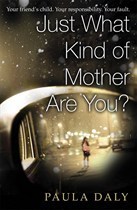 I was on Twitter last week and I got a message from Alison Barrow at Transworld publishers asking if I'd like to read a debut novel set in the Lake District. Like most writers I have several jobs and a work-in-progress waiting, and I find I have to carve out time to read books I want to read, let alone review ones I'd never heard of. But I mailed Alison back to ask what genre, and she said 'psychological thriller'. I ummed and aaahed, but then thought - but it's the Lake District, the place I actually live. So I agreed to read it and I'm so glad I did because if I hadn't I would have missed a fabulous read.
I was on Twitter last week and I got a message from Alison Barrow at Transworld publishers asking if I'd like to read a debut novel set in the Lake District. Like most writers I have several jobs and a work-in-progress waiting, and I find I have to carve out time to read books I want to read, let alone review ones I'd never heard of. But I mailed Alison back to ask what genre, and she said 'psychological thriller'. I ummed and aaahed, but then thought - but it's the Lake District, the place I actually live. So I agreed to read it and I'm so glad I did because if I hadn't I would have missed a fabulous read.So I was feeling overstretched, and overworked, and over-committed to all the different things going on in my life and opened the book to find it was about a mother who was also overstretched, overworked and over-committed.
I so empathise with that feeeling.
Lisa is an exhausted mother of three. One day she takes her eye off the ball and completely forgets that her 13 year old daughter's friend was supposed to sleep over. That is until she finds out the girl has gone missing. This is the parent's second worst nightmare - someone else's child is missing and you are responsible. To make things worse, there is a rapist on the loose who is targeting young girls.
Lisa as the main character is empathic and interesting. Her job running a dog re-homing charity is one which is already a full-time occupation stretching well past working hours. Daly's depiction of Lisa's typical day will ring bells with many women who are trying to find the elusive work/home balance that probably only exists in the media and not in real life.
All the other characters possess the quirks and flaws that make for real human beings, and Paula Daly is adept at showing the subtle power games that go on between female friends and between husbands and wives. Told from several points of view, including that of the local female police officer who is attempting to solve the crime, this will satisfy lovers of crime fiction and would also make a great Book Club pick.
Once you have begun this well crafted book you will find it impossible to put it down until you finish it and find out the less-than-obvious fate of the missing girl. I found I was reading through meals, reading whilst others were watching TV, staying up late to finish it. 'Just What Kind of Mother are You?' is a well-plotted, believable thriller with plenty to make you think, and I for one can't wait for Paula Daly's next book.
And of course I shall be recommending it to my unsuspecting book group who meet in Windermere where the book is set. And indeed to anyone who asks me what to read next.
(By the way, this is probably not the UK or US cover, but the NZ cover, which was the only one I could find online. My ARC was in a plain white jacket as the book has not been released yet.)
Published on March 11, 2013 09:47
March 8, 2013
Enjoying cliché - Writing Tips from Helen Hollick, author of Ripples in the Sand
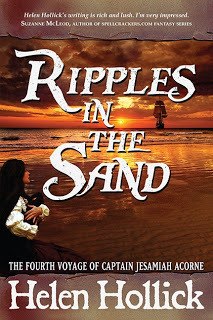
Today I'm delighted to welcome Helen Hollick, author of the bestselling Arthurian Trilogy which includes 'The Kingmaking', and now releasing her fourth book about the pirate, Captain Jesamiah Acorne.
Hi Helen, I am looking forward to reading about Jesamiah Acorne. What for you makes a good hero, a good heroine and a good villain, and how do you make them believable and not a cliché for a modern reader?
In some ways, the clichéd hero, heroine and villain is partly expected and therefore enjoyed, but this depends on the book, the characters and the plot! I suppose my Jesamiah is a little clichéd in the fact that he is tall, dark, and good looking. He is the sort of hero you wouldn’t want to meet in a dark alley if you’d previously upset him – quick to smile, but formidable when angry – you can rely on him to be there (cutlass or pistol in hand) when he’s needed. He isn’t fazed by danger, won’t tolerate unnecessary cruelty or disrespect to women, but is not always ‘polite’ with his language. (He is a pirate, and pirates don’t use genteel language do they?) He is more than capable of getting drunk if the rum is available, and his morals slip occasionally when there’s a good-looking woman tempting him. But he is loyal to his men, and would give his life for his woman, Tiola – indeed he took a flogging on her behalf in the second Voyage, Pirate Code.
A heroine needs to be tough-minded, to know what she wants and be determined to get it. She must be true to her cause (be that her ‘quest’ or her man), capable of chucking the teddies out the cot when riled, but balance that with love without condition. As for the villain – the more dastardly the better *laugh*.
The adventures (and some tricky situations) that Jesamiah finds himself in possibly are clichéd – you know that if he is in trouble he is going to get out of it, as in any hero-type novel or movie, but the trick is to write at a good pace, keeping the pages turning and for the reader not to be able to guess how the hero gets out of trouble! Belief has to be suspended by action. No one believes any of the situations in the James Bond or Indiana Jones movies – but so what? They are not meant to be believed, they are meant to be enjoyed as a bit of escapism fun.
Jesamiah is a blend of C.C. Forrester’s Horatio Hornblower, Patrick O’Brian’s Jack Aubrey, Indiana Jones, James Bond and Bernard Cornwell’s Richard Sharpe… with a hefty dash of Captain Jack Sparrow added as a bonus! He has his flaws and weaknesses; he is not all ‘good guy’, there are times when you want to cheer him on – other times you could slap his face. That’s life – especially for an ex-pirate!
I enjoyed your book about writing and editing, 'Discovering the Diamond'. Can you give a historical fiction writer 3 short writing tips from the many 'gems' in your book?
Thank you Deborah – I wrote it with my UK main editor, Jo Field, because we were getting inundated with questions about writing, and found we didn’t have time to keep typing out the same replies. We figured a short, non-expensive, e-format booklet might prove useful, and we are delighted that Discovering the Diamond is serving its purpose and has been well received.
Three tips?
1. Don’t get so bogged down in research that you never get on with writing your story.
2. Don’t use ‘archaic’ language. ‘Gadzooks ye bounder’ might sound authentic, but believe me it is very irritating to read! Likewise, do not use modern language ‘OK’ sounds just as odd.
3. Watch those anachronisms. You cannot have ‘He froze like a rabbit caught in the headlights’ in a novel set in Tudor England where headlights haven’t been invented yet.

Thanks Helen, great tips and thank you for guesting on my blog.Helen is published by www.silverwoodbooks.co.uk
Published on March 08, 2013 01:21
March 5, 2013
Having a coffee in the 17th Century
 If I wanted a coffee in the 17th century I would not be asking for a 'latte' or a 'mocha'. In fact coffee then was contoversial and given a few less-than-flattering names.
If I wanted a coffee in the 17th century I would not be asking for a 'latte' or a 'mocha'. In fact coffee then was contoversial and given a few less-than-flattering names.‘Syrup and soot’ and ‘essence of old shoes’ were just two of the names given to coffee by innkeepers and tavern keepers in the 17thcentury. Threatened by the craze for coffee drinking, and fearing for their livelihood, they did everything in their power to close them down. Fortunately they didn’t succeed and today I am able to pop into my local Costa for a coffee and chat with friends just as Pepys did in his day.
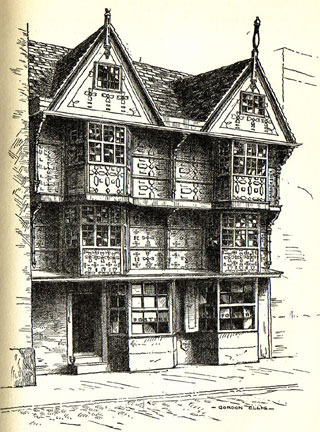 Turk's Head, Cambridge coffee house
Turk's Head, Cambridge coffee houseWhat would I find if I went into a coffee house in Pepys’s time? Well I’d have to get a man to accompany me, as women weren’t allowed unless they either owned it or worked there. I’d choose someone like Isaac Newton to be sure of an interesting conversation! I would look for the sign of a Turk’s Head, which often denoted a coffee house because of its Turkish origins.
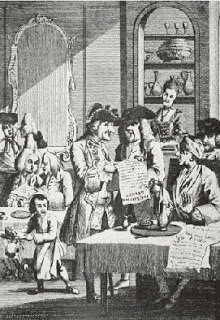
I would have to pay a penny at the door, which is a fee to say that I agree to the rules of the house. I would undertake not to gamble, swear, quarrel, or mourn over lost love. Obviously the ‘mourning over a lost love’ must have been a big problem! Because of this admission charge and the free exchange of ideas and opinions the coffee houses promoted, in Londonthey became known as “Penny Universities.”
If I inhaled, I might smell the beans roasting, a cause of great worry to bookseller neighbours in a Londonstill mostly half-timbered from Elizabethan times. Inside the house the atmosphere would be acrid and thick with tobacco smoke from innumerable long-stemmed pipes, not to mention the smoke from the damp sea-coal burning in the grate, and thin candles or rush-lights giving off their waxy smell. Add to this the unwashed bodies, delicately perfumed by pomanders, and the tang of perfumed or aromatic snuff, and I can see where the ‘essence of old shoes’ might have come from!
If I managed to brave the stench, then I might be astounded by the noise. Of course there was the hubbub of conversation in the background, interspersed by sneezes from the snuff-takers and the clattering of pots and pans, but also the turning of papers and broadsheets laid out on a long table at the side of the room, the hiss and bubble of the boiling coffee and the spit of the fire. But usually there would be somebody “holding forth”, declaiming on one subject or another, politics being a favourite. I would find politicians in the Cocoa-Tree in St James’s, whereas Wills Coffee House in Covent Gardenwas favoured by literati such as Dryden and Pope.
 Dryden meets Pope in Wills Coffee House
Dryden meets Pope in Wills Coffee House In The Gilded Lilythe dangerous rogue-about-town, Jay Whitgift, conducts his business in a London coffee house called the Pelican where he meets members of the Wits Club, a group of wealthy courtiers including the Duke of Buckingham and the Earl of Rochester. The antics of the Wits, or the Merry Gang, forever coloured the reputation of Charles’s court. The Pelican was based on Wills Coffee House, the real-life meeting place of the Wits who ‘entertained one another with their trifling composures…as if the fate of kingdoms depended on them’ Jonathan Swift
In a 17th century coffee house my coffee would be bitter, the beans boiled over the fire for days in ten gallon cauldrons, with the addition of wine, ale, or herbs and spices such as spearmint. I would sip it from a bowl with no handles. No wonder a “Satyr Against Coffee” (1674) called it ‘horse-pond liquor, witches tipple out of dead man’s skulls’ Thank goodness for my latte with a touch of sugar, and my brownie on the side!
In the Economist, 17th century coffee houses are described as “the internet in a cup”, and they fulfilled exactly this function. One of the things I love about going for a coffee is that it is invariably with friends, and that the conversation and exchange of ideas is as important as the drink. http://www.economist.com/node/2281736
I blog with Hoydens and Firebrands, where you can find another excellent article about coffee houses by Anita Davison.
I can also recommend: Life in a 17thcentury Coffee Shop by David BrandonThe Lives of the English Rakes by Fergus LinnaneRestoration London by Liza Picard
This post first appeared on the great blog HISTORICAL TAPESTRY, why not pop over there for a look at the excellent range of articles, reviews and giveaways.
Published on March 05, 2013 01:35



